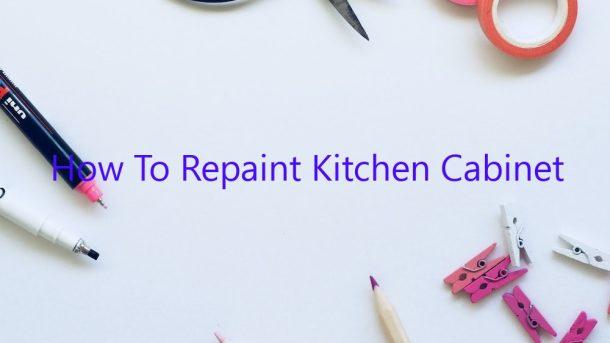A fresh coat of paint can work wonders for updating a kitchen cabinet. Whether the cabinet is in good condition but just needs a new color, or it is showing its age and needs some repairs as well, repainting it is a cost-effective way to give it a new look.
However, before beginning the project, there are a few things to consider. First, how much work is needed to get the cabinet ready for paint? If the cabinet is in good condition, a light sanding may be all that is necessary. If there are any major flaws, such as water damage or peeling paint, those will need to be repaired before painting.
Second, what color should the cabinet be painted? This depends on the overall look that is desired. There are a wide variety of colors to choose from, or the cabinet can be painted a contrasting color to the walls for a bold look.
Finally, what type of paint should be used? There are a few different types of paint that can be used for cabinets, including latex paint, enamel paint, and oil-based paint. Latex paint is the most common type of paint and is easy to apply. Enamel paint is a high-quality paint that is durable and can be used on cabinets that will be exposed to moisture. Oil-based paint is the most durable type of paint, but it is also the most difficult to apply.
Once these considerations have been made, the actual painting process can begin. First, the cabinet should be cleaned with a degreaser to remove any dirt or grease. Then, it should be sanded to provide a smooth surface for the paint to adhere to. After sanding, the cabinet should be wiped down with a tack cloth to remove any dust.
Next, the primer should be applied. This is a coat of paint that is used to seal the surface and to provide a base for the paint to adhere to. The primer should be allowed to dry completely before the top coat of paint is applied.
Finally, the cabinet can be painted. To ensure even coverage, it is best to apply the paint in thin layers. After the first coat has been applied, the cabinet should be allowed to dry completely before applying a second coat.
Once the cabinet is painted, it is important to protect it from scratches and moisture. A coat of polyurethane can be applied to help protect the paint.
Repainting a kitchen cabinet is a cost-effective way to give it a new look. By considering the condition of the cabinet, the color that is desired, and the type of paint that should be used, the painting process can be made easier.
Contents
- 1 Can you just paint over a cabinet?
- 2 Do you have to sand kitchen cabinets to repaint them?
- 3 What kind of paint do you use to paint over kitchen cabinets?
- 4 What happens if you don’t sand cabinets before painting?
- 5 What is the easiest way to paint cabinets?
- 6 Do you have to Prime cabinets before painting?
- 7 Do I need to prime cabinets before painting?
Can you just paint over a cabinet?
When you’re ready for a change in your kitchen but don’t want to spend the money on a whole new cabinet set, can you just paint over a cabinet? The answer is yes, you can, but there are a few things you need to know before you get started.
The first step is to remove the cabinet doors and all of the hardware from the cabinets. Make sure to label each piece of hardware so you know where to put it back when you’re finished. Next, you’ll need to sand down the surface of the cabinets. This will help the paint adhere to the surface better.
Once the cabinets are sanded, you can start painting. Be sure to use a high-quality paint specifically designed for cabinets. It’s also important to use a primer before painting. This will help the paint adhere to the surface and will help to prevent the paint from chipping.
Once the paint is dry, you can put the hardware back on the cabinets and put the doors back on. Give the paint time to cure before using the cabinets. typically, it takes about two weeks for the paint to cure completely.
Do you have to sand kitchen cabinets to repaint them?
When it comes time to repaint your kitchen cabinets, the first question that comes to mind is usually whether or not you have to sand them down first. The answer to this question is it depends on the paint you are using. If you are using a latex paint, you do not have to sand your cabinets down. However, if you are using an oil-based paint, you will have to sand them down before you can apply the paint.
What kind of paint do you use to paint over kitchen cabinets?
If you’re looking to give your kitchen cabinets a fresh look, painting them is a great option. But what kind of paint should you use?
There are a few factors to consider when choosing paint for kitchen cabinets. The first is the type of surface you’re painting. Kitchen cabinets can be made from a variety of materials, including wood, laminate, and plastic. The type of paint you use will vary depending on the surface you’re painting.
If you’re painting wood cabinets, you’ll need a primer and a paint designed for wood. If you’re painting laminate or plastic cabinets, you can use a spray paint designed for those surfaces.
The second factor to consider is the finish you want. Kitchen cabinets can have a variety of finishes, including a glossy finish, a matte finish, or a satin finish. The type of paint you use will also vary depending on the finish you want.
If you want a glossy finish, you’ll need to use a paint with a high gloss level. If you want a matte finish, you’ll need to use a paint with a low gloss level. If you want a satin finish, you can use either a paint with a high gloss level or a paint with a low gloss level.
The third factor to consider is the color you want. Kitchen cabinets come in a variety of colors, so you should choose a paint that will match or complement your cabinets.
Once you’ve considered these factors, you can choose the right paint for your kitchen cabinets.
What happens if you don’t sand cabinets before painting?
If you’re wondering what happens if you don’t sand cabinets before painting, the answer is that you’ll likely end up with a cabinets that are not only unpainted, but also unpolished. This is because sanding is an essential step in the painting process, as it helps to create a smooth surface for the paint to adhere to. If you try to paint over a surface that hasn’t been sanded, the paint will likely chip or crack, resulting in an unsightly finish.
In addition to creating a smooth surface, sanding also helps to remove any debris or dust that may be on the surface of the cabinets. This is important, as any dirt or dust that is left on the surface can cause the paint to chip or crack.
If you’re not sure how to sand cabinets before painting, there are a few things that you can do. The first is to use a fine-grit sandpaper, such as a 120-grit sandpaper. This type of sandpaper is perfect for removing any debris or dust from the surface of the cabinets. The next step is to use a medium-grit sandpaper, such as a 220-grit sandpaper. This type of sandpaper is perfect for creating a smooth surface.
Once you’ve sanded the cabinets, it’s important to clean them off with a damp cloth. This will remove any of the dust or debris that may have been left behind. Once the cabinets are clean, you’re ready to start painting them.
What is the easiest way to paint cabinets?
Cabinets are a big part of any room and can really make or break the design. If your cabinets are outdated or just not your style, you may be considering painting them. But what is the easiest way to do this?
There are a few things to consider when painting cabinets. The first is the type of paint you want to use. There are a few different options, but the most popular is latex paint. Latex paint is easy to apply and dries quickly. It is also affordable and easy to find.
Another thing to consider is the color of the paint. Choosing a light color can make a room feel bigger, while darker colors can make a room feel more intimate. You may also want to consider the finish of the paint. A matte finish is the most popular, as it is easy to clean and doesn’t show fingerprints or smudges.
The easiest way to paint cabinets is to remove all of the cabinet doors and hardware and paint them in a well-ventilated area. You can use a paintbrush or a roller to apply the paint. Be sure to paint the edges and corners of the cabinets, as these are often missed.
Once the paint is dry, you can reattach the doors and hardware. If you want to change the color of your cabinets, you can easily do this by painting them a different color.
Painted cabinets can really update a room and make it look like a new space. If you’re considering painting your cabinets, the easiest way to do it is by using latex paint and a brush or roller. Be sure to choose a light or dark color and a matte finish to get the look you want.
Do you have to Prime cabinets before painting?
When painting cabinets, do you have to prime them before you start? The answer is, it depends. If your cabinets are made of a wood that is not very porous, like oak, you may be able to get away without priming them. However, if your cabinets are made of a more absorbent wood, like pine, you will definitely need to prime them before painting.
Priming is important because it helps the paint adhere better to the surface of the cabinet. This means that the paint will last longer and look more polished. If you try to paint cabinets without priming them, you may find that the paint starts to chip and peel after a while.
If you are not sure whether or not your cabinets need to be primed, it is best to err on the side of caution and go ahead and prime them. This will ensure that your cabinets look great for years to come.
Do I need to prime cabinets before painting?
If you’re painting your cabinets, you may be wondering if you need to prime them before painting. The answer is: it depends.
If your cabinets are made from a solid wood, such as oak or maple, you will definitely need to prime them before painting. This is because solid wood cabinets tend to absorb a lot of paint, and without primer, the paint will not adhere to the surface properly.
If your cabinets are made from a composite material, such as particleboard or MDF, you may not need to prime them before painting. However, it is a good idea to do so, as it will help the paint to adhere better and will result in a more durable finish.
If you are unsure whether or not you need to prime your cabinets, it is always best to err on the side of caution and prime them anyway. This will ensure that your cabinets will look their best when they are finished.




